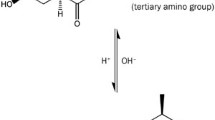Abstract
Purpose. To evaluate the aqueous transfer model as the mechanismfor the micelle-mediated uptake of phenol in the rat in situ intestinalperfusion model.
Methods. Phenol in isotonic HEPES buffer was perfused through thejejunal segment at two flow rates and at various concentrations. Phenolwas then dispersed in two, distinct mixed micelle systems composedof sodium taurocholate and phosphatidylcholine at 10 mM:2.5 mM(10:2.5 system) and at 10 mM: 10 mM (10:10 system) and its uptakestudied in each case. Equilibrium dialysis was done to determine theaqueous fraction of phenol in each system.
Results. The Peff of phenol in isotonic HEPES buffer at a low flowrate (n = 6) was 1.7 ± 0.4 × 10−4 cm/s and at a high flow rate(n = 13) was 1.8 ± 0.5 × 10−4 cm/s. The Peff for the 10:2.5 systemat the high flow rate (n = 3) was 1.5 ± 0.4 × 10−4 cm/s and at thelow flow rate (n = 3) was 1.4 ± 0.3 × 10−4 cm/s. Uptake wasmembrane rate-limited in both the non-micellar and 10:2.5 systems.Peff at a high flow rate (n = 3) in the 10:10 system was 1.3 ± 0.1 ×10−4 cm/s. Equilibrium dialysis (n = 4) revealed free fractions of 0.60± 0.05 and 0.50 ± 0.03 for the 10:2.5 and 10:10 systems.
Conclusions. The uptake of micellized phenol did not follow theaqueous transfer model of uptake.
Similar content being viewed by others
REFERENCES
Y. K. Pithavala, J. L. Odishaw, S. Han, T. S. Wiedmann, and C. L. Zimmerman. Retinoid absorption from simple and mixed micelles in the rat intestine. J. Pharm. Sci. 84:1360–1365 (1995).
D. D. Lasic. Mixed micelles in drug delivery. Nature 355:279–280 (1992).
J. R. O'Reilly, O. I. Corrigan, and C. M. O'Driscoll. The effect of mixed micellar systems, bile salt/fatty acids on the solubility and intestinal absorption of clofazimine (B663) in the anesthetized rat. Int. J. Pharm. 109:147–154 (1994).
Y.-F. Shiau. Mechanism of intestinal fatty acid uptake in the rat: The role of an acidic microclimate. J. Physiol. 421:463–474 (1990).
S. Burdick, M. Keelan, and A. B. R. Thomson. Different mechanisms of uptake of stearic acid and cholesterol into rabbit jejunal brush border membrane vesicles. Lipids 28:1063–1067 (1993).
J. M. Dietschy. Mechanisms for the intestinal absorption of bile acids. J. Lipid Res. 9:297–309 (1968).
H. Thurnhofer and H. Hauser. The uptake of phosphatidylcholine by small intestinal brush border membrane is protein-mediated. Biochem. Biophys. Acta. 1024:249–262 (1990).
H. Thurnhofer and H. Hauser. Uptake of cholesterol by small intestinal brush border membrane is protein-mediated. Biochemistry 29:2142–2148 (1990).
A. B. R. Thomson and B. D. O'Brien. Uptake of cholesterol into rabbit jejunum using three in vitro techniques: Importance of bile acid micelles and unstirred layer resistance. Am. J. Physiol. 241:G270–G274 (1981).
M. C. Carey and D. M. Small. Micelle formation by bile salts: Physical-chemical and thermodynamic considerations. Arch. Int. Med. 130:506–527 (1972).
N. A. Mazer, G. B. Benedek, and M. C. Carey. Quasielastic light-scattering studies of aqueous biliary lipid systems. Mixed micelle formation in bile salt-lecithin solutions. Biochemistry 19:601–615 (1980).
C.-Y. Li. Study of the diffusion and solubilization of the bile salts/phospholipid aggregates. Ph.D. Thesis University of Minnesota (1997).
J. L. Pope. Crystallization of sodium taurocholate. J. Lipid Res. 8:146–147 (1967).
T. Niwa. Phenol and p-cresol accumulated in uremic serum measured by HPLC with fluorescence detection. Clin. Chem. 39:108–111 (1993).
P. S. Chen Jr., T. Y. Toribara, and H. Warner. Microdetermination of phosphorus. Anal. Chem. 28:1756–1758 (1956).
F. Nakayama and M. Nakagaki. Quantitative determination of bile acids in bile with reversed-phase high-performance liquid chromatography. J. Chrom. 183:287–293 (1980).
I. Komiya, J. Y. Park, A. Kamani, N. F. H. Ho, and W. I. Higuchi. Quantitative mechanistic studies in simultaneous fluid flow and intestinal absorption using steroids as model solutes. Int. J. Pharm. 4:249–262 (1980).
W. L. Hayton. Rate-limiting barriers to intestinal drug absorption: A review. J. Pharmacokin. Biopharm. 8:321–334 (1980).
F. A. Wilson, V. L. Sallee, and J. M. Dietschy. Unstirred water layers in intestine: Rate determinant of fatty acid absorption from micellar solutions. Science 174:1031–1033 (1971).
F. A. Wilson and J. M. Dietschy. Characterization of bile acid absorption across the unstirred water layer and brush border of the rat jejunum. J. Clin. Invest. 51:3015–3025 (1972).
Y. K. Pithavala. The absorption of retinoid analogs from micellar systems in the rat intestine. Ph.D. Thesis University of Minnesota. (1995).
Author information
Authors and Affiliations
Rights and permissions
About this article
Cite this article
Kothare, P.A., Zimmerman, C.L. The Intestinal Uptake of Phenol from Micellar Systems Does Not Conform to the Aqueous Transfer Model. Pharm Res 17, 839–843 (2000). https://doi.org/10.1023/A:1007560309582
Issue Date:
DOI: https://doi.org/10.1023/A:1007560309582




